May 9 – Wed
We departed Edisto Island after only 1 night on Wednesday and headed for an exciting stop in Charleston South Carolina. Along with St Augustine, Savannah, & Beaufort, this is one of the highly anticipated cities on the southeast coast.
We arrived at the Charleston City Marina about 1pm at the peak of tide current. So we had current pushing us one way, wind pushing us one way, boats in front / behind our dock space, and we were in a somewhat narrow fairway on the inside of the Charleston Harbor Mega-Dock. With no bow/stern thrusters, we were a little nervous, but the docking experience gained through the Loop paid off and the event turned out to be an easy docking after doing a 180 turn & heading into the current (as we always do). The Mega-Dock is 1530ft long, and Charleston City Marina has over 19,000 feet of linear dock space. Here is a photo of the long Mega-Dock.
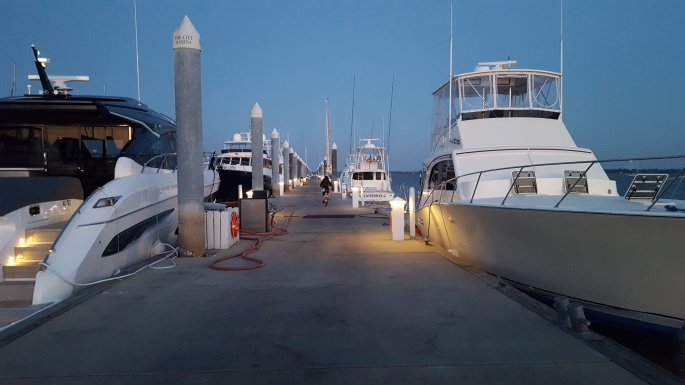
The marina is very nice for a City Marina, they have Cable TV, 7 private shower rooms, and a shit-load of young dock hands who are all very good and very nice.
They also have a couple interesting pump-out boats named ; The Grateful Head & The Bow Movement.


After gettin’ tied up & cleaned up, we headed into downtown Charleston and walked around the City Market area, got some tickets for a carriage ride the next morning, and then went to dinner.
While purchasing the carriage tour tickets, I picked the local’s brains about restaurants. They recommended several places , one of them being Poogan’s Porch.
Poogan’s Porch on Queen street, is one of Charleston’s oldest establishments, & recognized by Martha Stewart Living, Wine Spectator and The Travel Channel.
The building was built in 1888, but not allowed to be converted to a restaurant until 1976. The previous owners of the house sold their home and moved away. A little, down-home southern dog named Poogan stayed behind. Poogan had been a neighborhood fixture for years, wandering from porch to porch, in search of back scratches and table scraps, endearing himself to all. From his proud porch perch, he served as the official greeter. It seemed only right to the name the restaurant after him. Poogan died a natural death in 1979. His porch and restaurant live on in his honor.
The place looks pretty small from the front, but I walked through the place and it was huge on the inside with many rooms downstairs, upstairs, & in a rear courtyard. Jonell & I ate at 1 of 4 tables in what appeared to be the small living room on the 1st floor in the front of the building.
The food was again awesome.
> I had the Roasted Duck Pirloo (Seared Duck Breast, Andouille Sausage, Wild Mushrooms, Anson Mills Middlins Rice, Merlot Gastrique)
> Nellie had the Cornmeal Fried Catfish (Local Étouffée, Collard Greens, Red Rice Hoppin’ John).
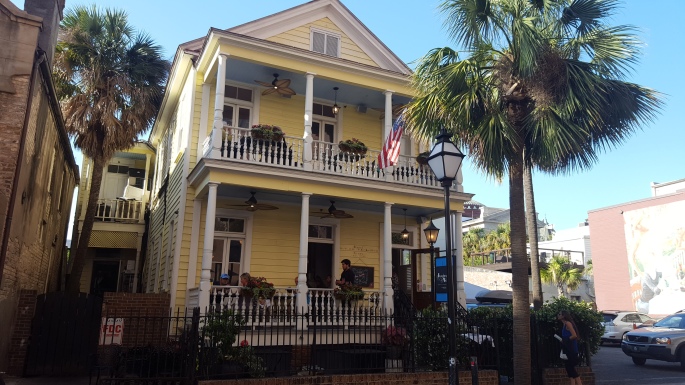

The place had MANY photos on the wall of famous people who had eaten there, here is one from the god-father of soul.

After dinner we walked around a place called the Vendue Park. The park is on the waterfront. Charleston is essentially on a peninsula , surrounded by water on 3 sides. The park had several fountains.

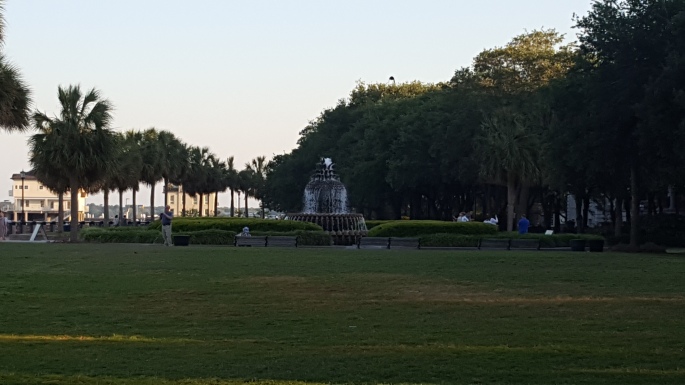
Near the Vendue Waterfront Park, we went to the Vendue Hotel & Roof Top Bar. There was a nice 3 piece Jazz band on the lower level bar of the hotel, but we took the elevator up to the roof top for the great views. When we got to the roof top, it was somewhat disappointing, with the roof being at the same level as surrounding buildings – we saw only the top of buildings & AC units (Bla). As we were about to leave, Jonell spotted another stairway going up another level. We took the stairway and found the real roof top bar. It was better, but still not as great as the roof top we had experienced at the Madison Hotel in Memphis. We had one drink and booked
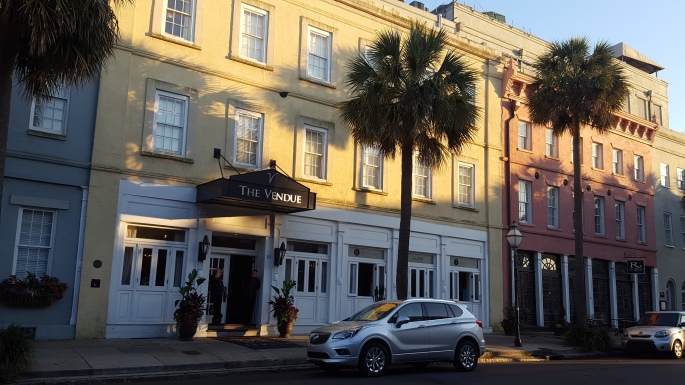
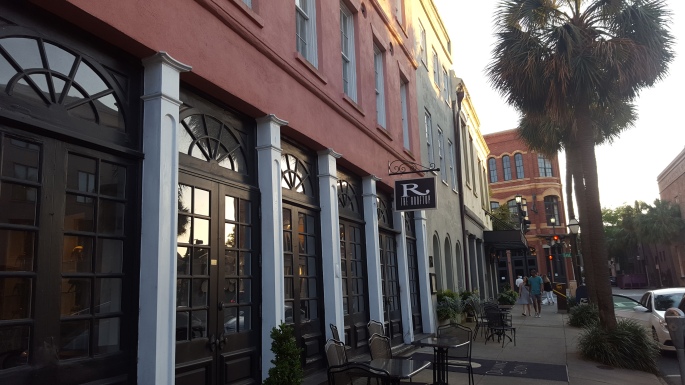
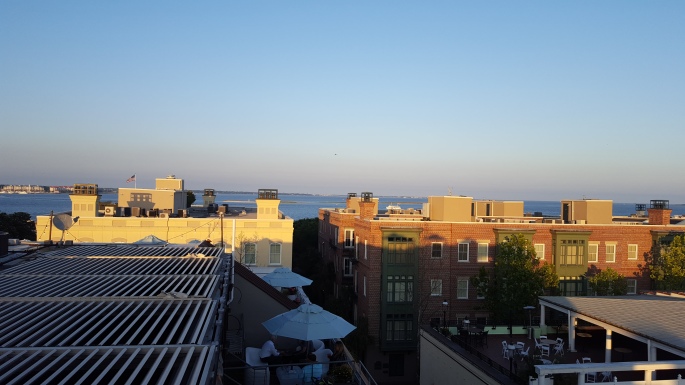
Overall, it was a great 1st half-day & night in Charleston.
May 10 – Thu
On Thursday, we had an early rise at about 7am in order to arrive at our 9am Carriage Ride Tour time. We like to use the carriage rides to get the initial feel for what to do & seen in a new city. Today we had tour guide Aaron & horse Abba. Abba is a very large Belgian Draft Horse, known as a work-horse.
As with previous carriage rides, we learned a lot about the city’s history & the main attractions to see.
The Charleston History – Quick Version (sorry, the history lessons will soon be over).
> Founded by British colonists in 1670.
> Charleston grew from a colonial seaport to a wealthy city by the mid 1700’s.
> Through the mid 1800’s, Charleston’s economy grew due to its busy seaport and the cultivation of rice, cotton, and indigo.
> In April of 1861, Confederate soldiers fired on Union-occupied Fort Sumter in Charleston Harbor, historically known as the 1st shot of the Civil War.
> Charleston was slow to recover from the devastation of the war. But its pace of recovery became the foundation of the city’s greatest asset – its vast inventory of historically significant architecture.
> Short on capital after the war, Charleston was forced to repair its existing damaged buildings instead of replacing them.
> After the war, the City gradually lessened its dependence on agriculture and rebuilt its economy through trade and industry. Construction of the Navy Yard in 1904 financially boosted Charleston into the 1900’s.
> During the first few decades of the 1900’s, industrial and port activities increased dramatically. Later, major sources of money came from the Charleston Naval Base, the area’s medical industry, and the tourism industry.
> Today, approximately 4.51 million people visit the city annually, generating an estimated economic impact of $3.22 billion.
During the tour, Aaron discussed several tidbits about the city
> Charleston was initially built as the only Walled Colonial City, with a 17 foot tall wall.
> It is known as The Holy City, with over 90 churches.
> They claim to be 2nd to only Rome, in historic buildings.
> Lots of the current city of Charleston, is built on landfill.
> Charleston is in the shape of a peninsula, and is only 1 mile wide x 3 miles long.
> Charleston was heavily involved in slavery, processing over 40% of 600,000 slaves.
> It is one of the best culinary cities in the country.
There are MANY things to see & do in Charleston.
I had a very long desired “To-Do” itinerary, and have listed below in Green, which of the attractions we were successful in visiting. In only 3.5 days of time, we had a large task list and did not make all the attractions.
> Carriage Rides
> The City Market – a 4 block long, enclosed set of vendors selling everything !
> Historic Churches – called the Holy City, over 90 churches.
> The Old Exchange – 1 of 4 places left in the USA, where the Constitution was ratified.
> The Old Slave Museum – a place where slaves were bought & sold.
> Rainbow Row – a row of brightly colored houses dating back to the 1700’s.
> The Battery & Whitepoint Gardens – Historic Mansions & a large park on the waterfront, over-looking Charleston Harbor and Fort Sumter.
> Fort Sumter – site of the 1st Shots of the Civil War.
> The Hunley – 1st submarine ever, to achieve a successful battleship sinking (Civil War)
> The Aquarium – possessing 1 of only 13 Albino Alligators in the USA
> The Angel Oak – 1400 years old, 65 ft tall, and has a 65ft circumference.
> Plantations – Boone-Hall, Magnolia, Draton-Hall, & Middleton
> Ravenel Bridge – The third longest cable-stayed bridge in the Western Hemisphere.
> King Street Shops – high-end stores like Louis Vuitton.
Most of the above was done on Friday, it was a very long day, I walked Nellie’s legs off, I think we covered about 7-8 miles of walking between 10am-6pm.
Here ya go, I’ll try to keep it short.
> We started the day with the Carriage Ride – Tour Guide Aaron & Horse Abba
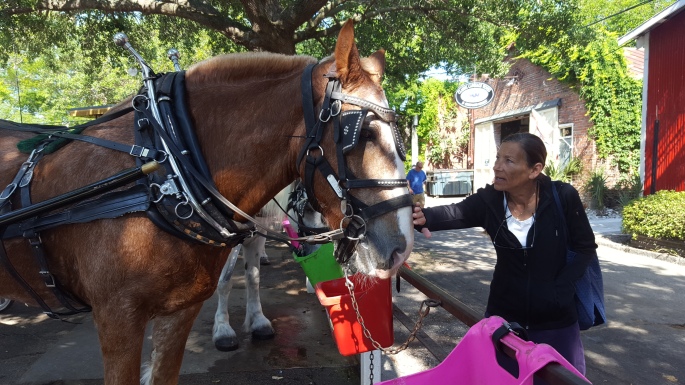
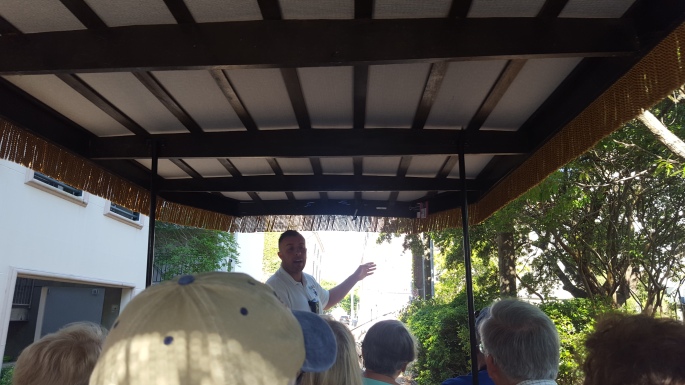
After the Carriage Ride, at 10am, we walked thru the City Market.
> The City Market is a 4 block long brick enclosed structure originated in 1796. Throughout the 1800’s, the market provided a convenient place for area farms and plantations to sell beef and produce, and also acted as a place for locals to gather and socialize. Today, the City Market’s vendors sell souvenirs and other items ranging from jewelry to Gullah sweetgrass baskets. Charleston is known for the basket weaving.

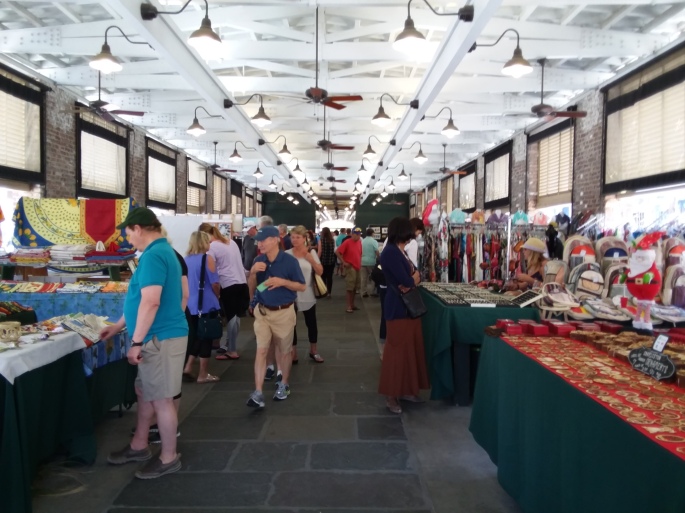
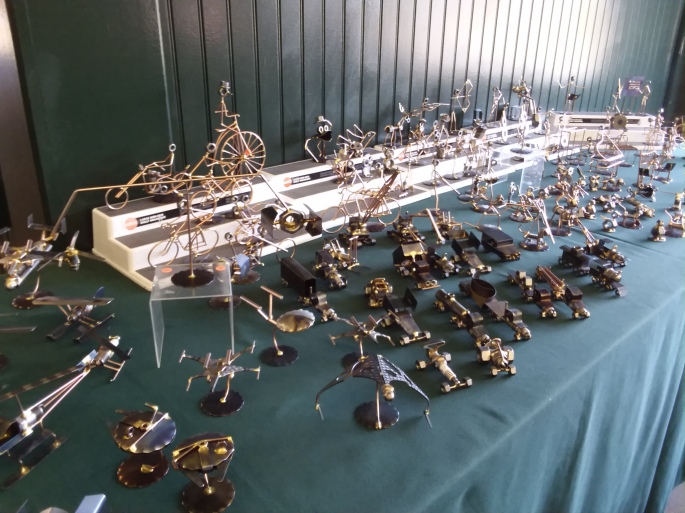



After the City Market, we took a short walk down King Street.
King street is listed by the U.S. News and World Report as one of the “Top 10 Shopping Streets in the USA.”

After The City Market & the King street Shops, we took a Breakfast Break at the Café Framboise, and shared a croissant.
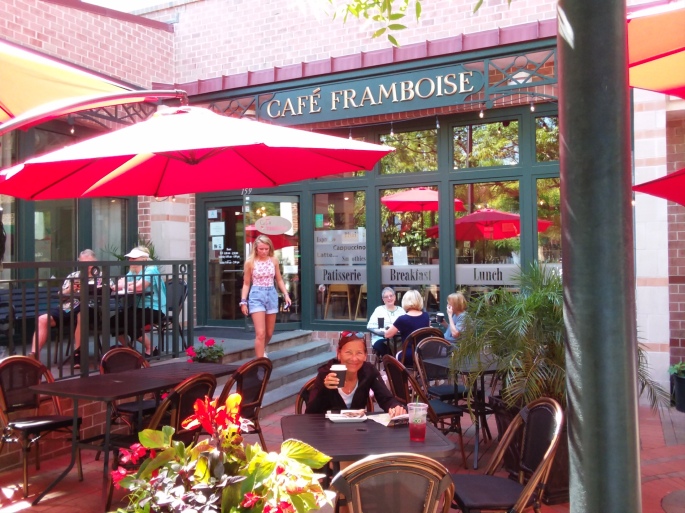
After breakfast, we went to see a few of the 90 Historic Churches
An interesting story from the tour guide was that during the civil war, most of the steeples were bell-less, with the copper bells removed, melted, and used for war supplies.



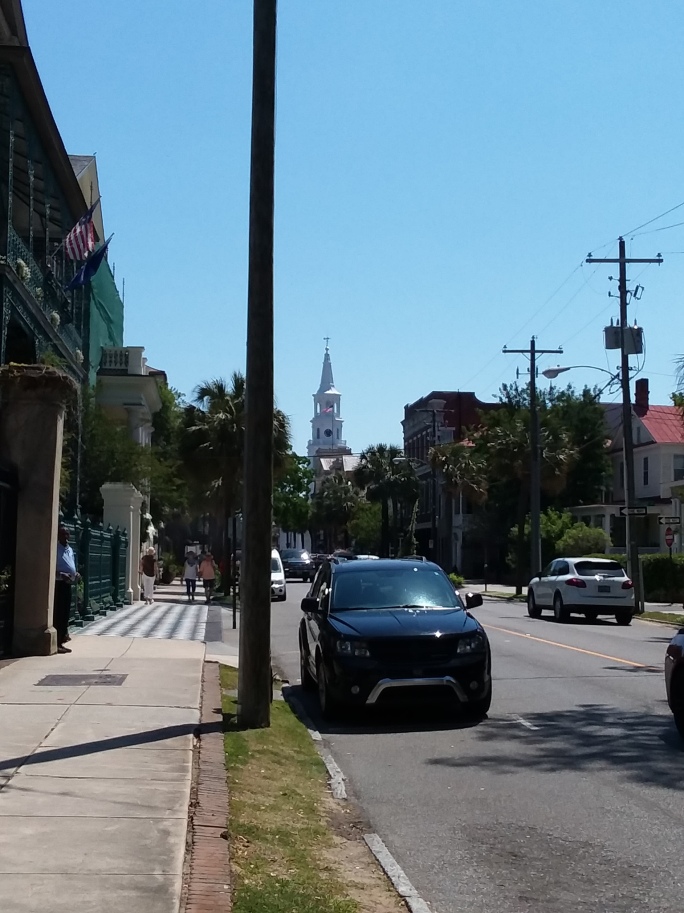
After seeing some of the many churches, we went to a place called The Old Exchange & Provost Dungeon. The docent Susan led us on a wonderful tour and history lesson.
> Built in 1771, a Charleston landmark and the site of some of the most important events in South Carolina history. The building has been a commercial exchange, custom house, post office, city hall, military headquarters, and museum.
> During the American Revolution (1775-1783), British forces converted the bottom floor of the Exchange into a military prison known as the Provost or “dungeon.” American prisoners of war, private citizens, and enslaved people all endured its harsh confines.
> In 1788 the Exchange upper floors hosted South Carolina leaders as they debated and approved the U. S. Constitution. Today, the Old Exchange Building is one of only four structures remaining where the Constitution was originally ratified.
> In 1791, city leaders entertained President George Washington at the Exchange with a series of lavish dinners, concerts, and dances, attended by hundreds of members of Charleston’s elite.
> Between the American Revolution and the Civil War, the Exchange was Charleston’s most common destination for public slave auctions, making the site one of the most important in the history of the domestic slave trade.
> Today, it is a non-profit historic site that focuses on the American Revolution and Colonial Charleston.
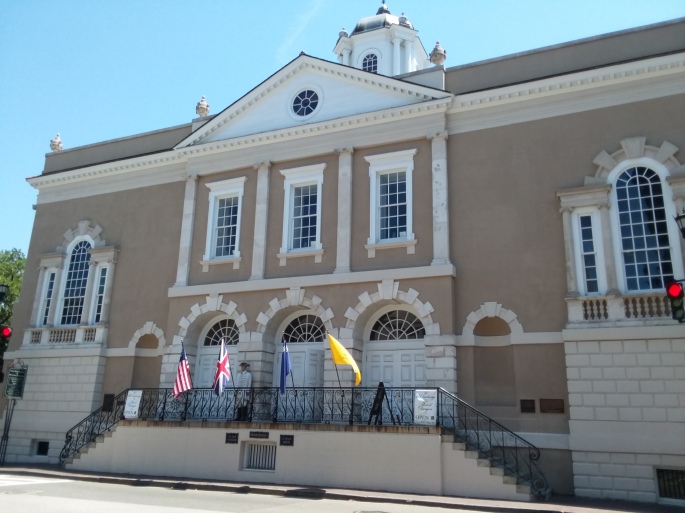
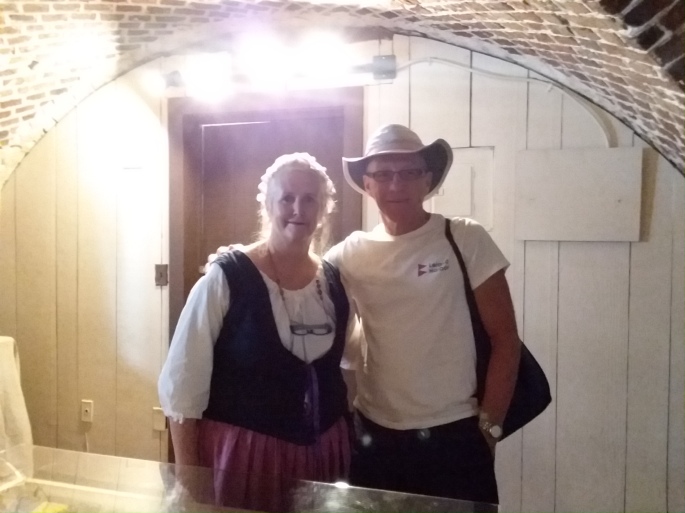
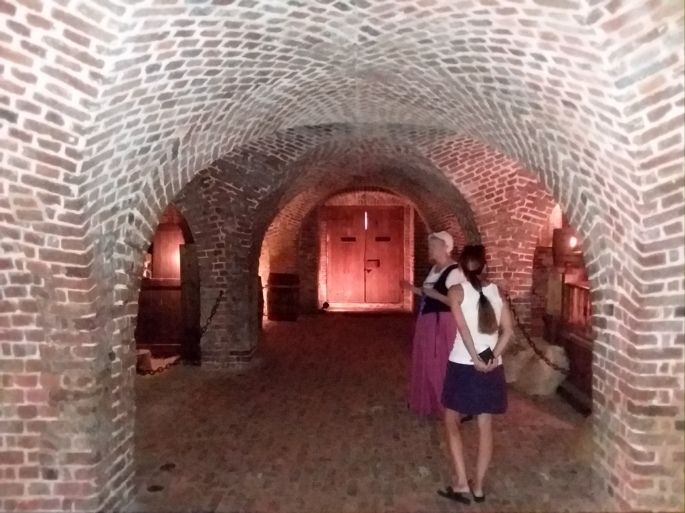


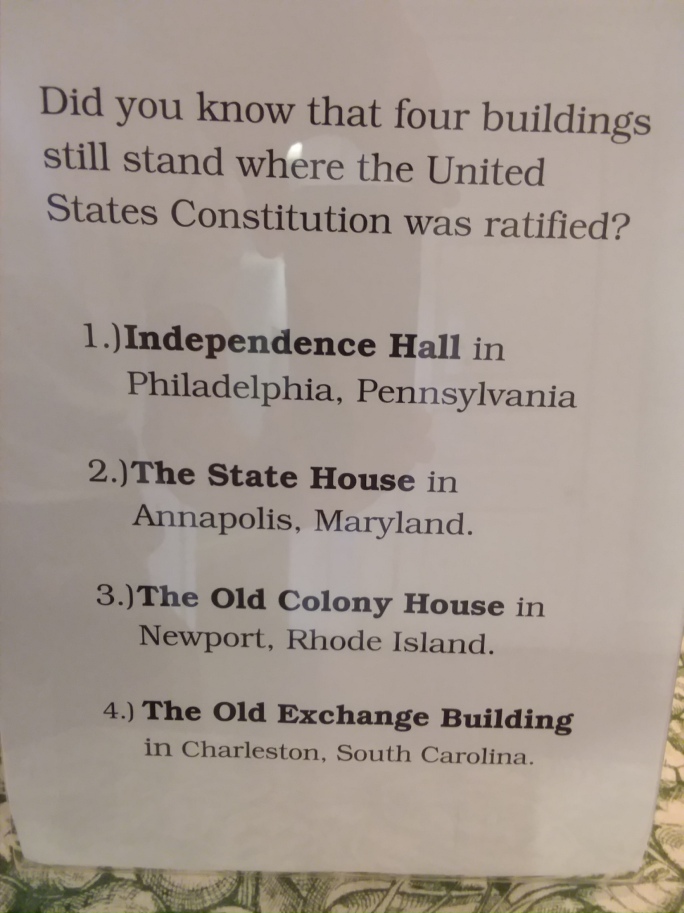
After the Old Exchange, we went to lunch at the Brown Dog Deli.
While on the way to the Brown Dog, we passed a place called The Tavern, claiming to be the Oldest Liquor Store in the country ??
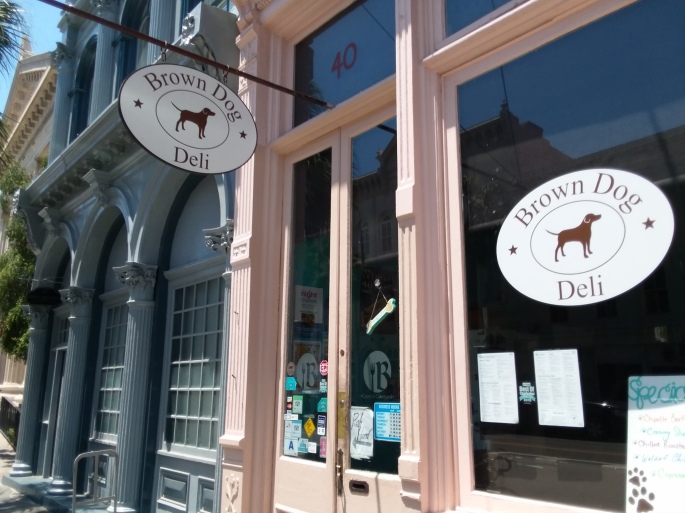


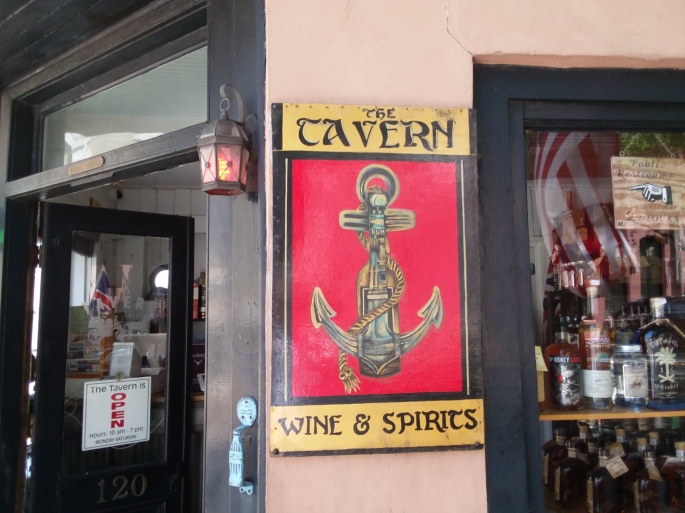
After lunch we continued Jonell Buehler’s Day-Off, and headed to a place called The Old Slave Mart Museum.
The Old Slave Mart visit was an eerie/riveting experience, feeling like I would imagine a holocaust museum feels. The story goes as follows ;
> Originally, the slaves were bought & sold on the open streets and city sponsored places like the Old Exchange building we discussed earlier in the blog.
> As pressure grew from the north & the abolitionists, open slave trading was outlawed, but the process was not yet made illegal.
> Entrepreneurs began building enclosed structures in which to continue the slave trading. The Old Slave Mart was 1 of about 40 enclosed slave auctions galleries in Charleston.
> Constructed in 1859, the building is believed to be the last existing slave auction facility in South Carolina. In 1975, the Old Slave Mart was added to the National Register of Historic Places for its role in Charleston’s African-American history.
> The museum did not allow photographs, but had many old photos, audio recordings of auctions (spooky), audio recordings of ex-slaves and their experiences, discussions on how the slaves bartered with potential new owners attempting to keep their families together (saying ” I will work hard for you if you take my family too”).
> One of the most riveting things for me was some photos & recordings showing how the sellers would prep the slaves for auction ; feeding/fattening, dying gray hair of older slaves, using lotions on the skin to heal or hide shackle wounds and whipping marks. Finally dressing the slaves in brand new clothing.
It seemed like prepping a car for resale, it gave us a sick feeling.
> Another memorable experience was looking at the auction brochures advertising the upcoming auction. The flyers listed the date/time of the auction & each slave on the upcoming auction block – their size, weight, age, their skills (general laborer, skilled worker, cooks, nannys), any “defects” like a previously broken leg. Prices ranged from $1000-2500. The slaves were frequently passed down in wills between family members, or used to pay debts.
> Charleston was evidently at the epicenter of the slave trading, reportedly processing 35-40% of 600,000 slaves.
> The Old Slave Mart Museum is the only site of its kind in South Carolina.
After the eerie experience and history lesson, we walked to Rainbow Row – the name for a series of thirteen colorful historic houses from the 1700’s. It represents the longest cluster of “georgian row houses” in the United States. The name Rainbow Row was coined after the pastel colors they were painted, as they were restored in the 1930’s and 1940’s. It is a popular tourist attraction and is one of the most photographed parts of Charleston.
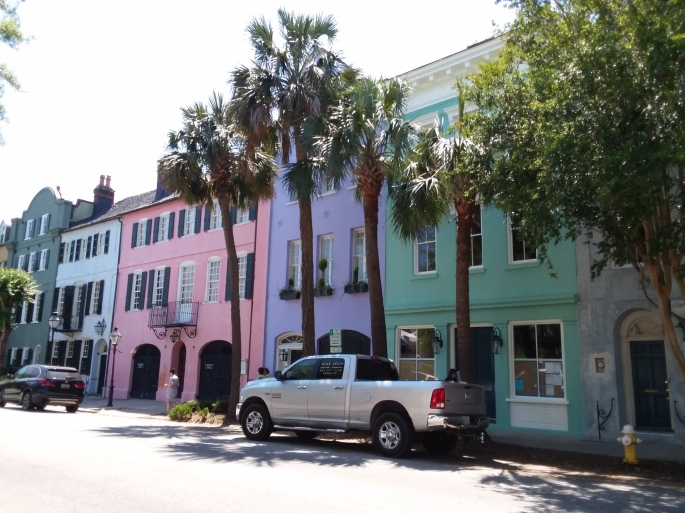
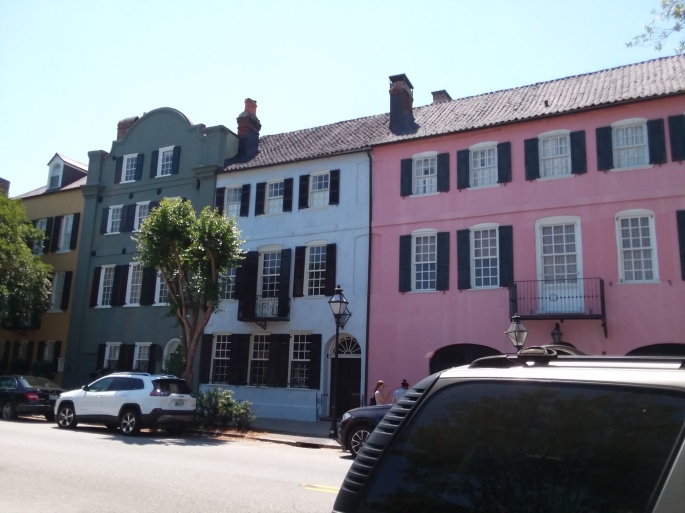
After Rainbow Row, we headed on to The Battery & nearby Whitepoint Gardens.
As a tourist destination, The Battery is famous for its stately antebellum mansions. But earlier in history it was a landmark defensive seawall where the army generals & rich socialites could overlook the Charleston Harbor & Fort Sumter. The nearby Whitepoint gardens still show the cannons which helped create the name The Battery.
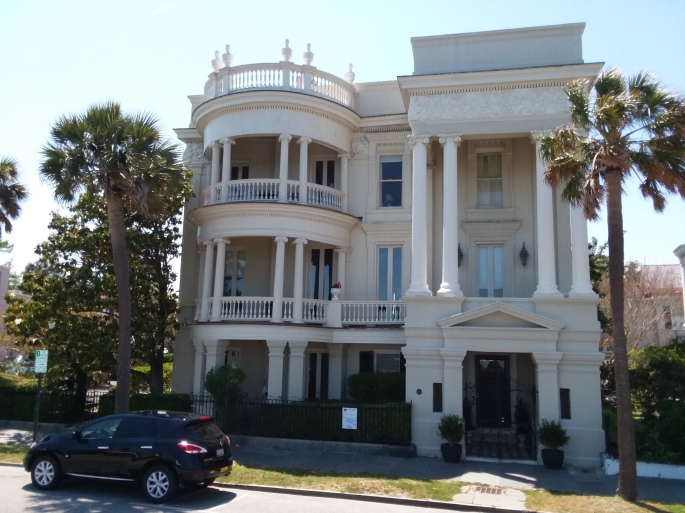


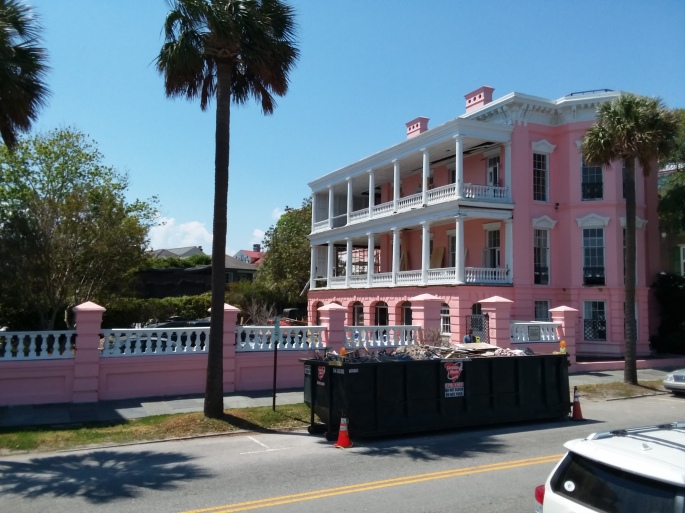


We concluded the late afternoon, now about 4pm, at the Nathaniel Russell House.
Built by a wealthy shipping merchant Nathaniel Russell in 1808, it is recognized as one of America’s most important Neoclassical houses. It was designated a National Historic Landmark in 1973.
The draw to the house was that the interior was supposed to be exactly as it was originally built, paint colors verified by forensics, and a crazy 3 story spiral staircase. After some of the attractions above, this one seemed ho-hum to us (5 rating on the Murphree tourist scale).
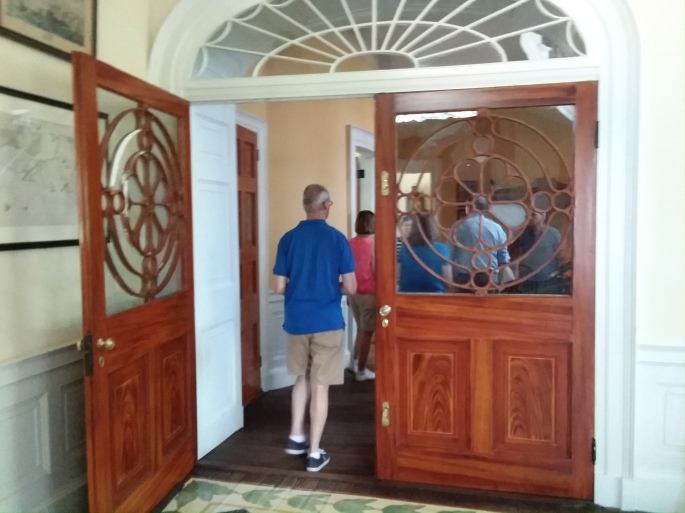
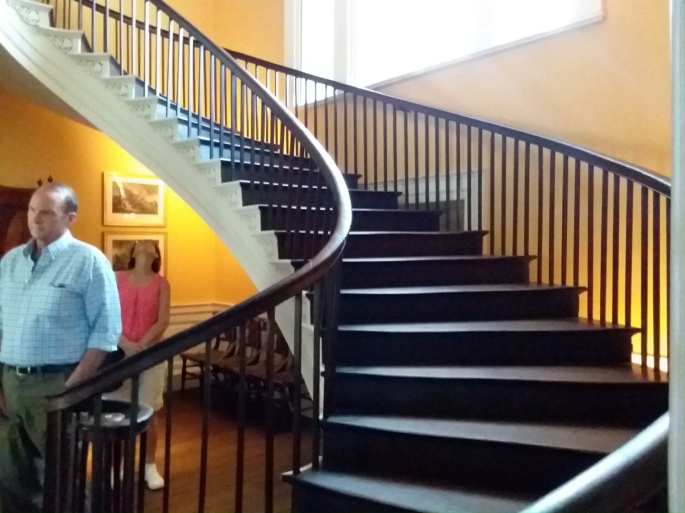

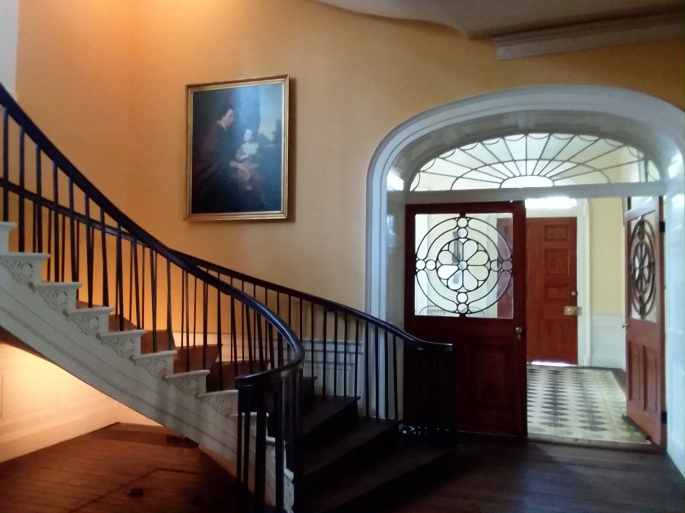

It was now about 5pm, closing time for most attractions, and team Murphree was whipped. It was time to head back to the SS Gettin’ Looped, and take a well deserved pre-dinner siesta !
Dinner was very low-key on Friday night, with a 2 mile bike ride to the local community college area, and burgers & beer at the Big Gun Burger & Bar.
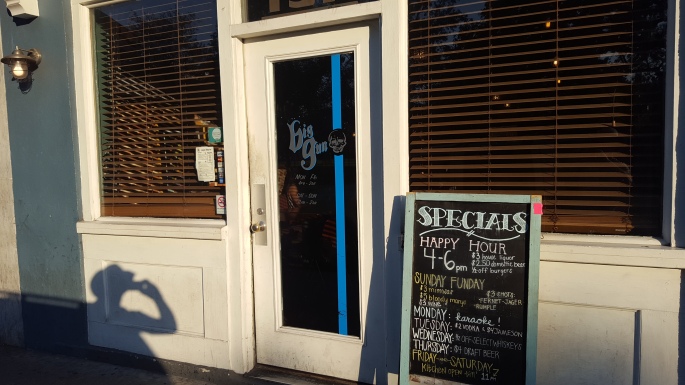
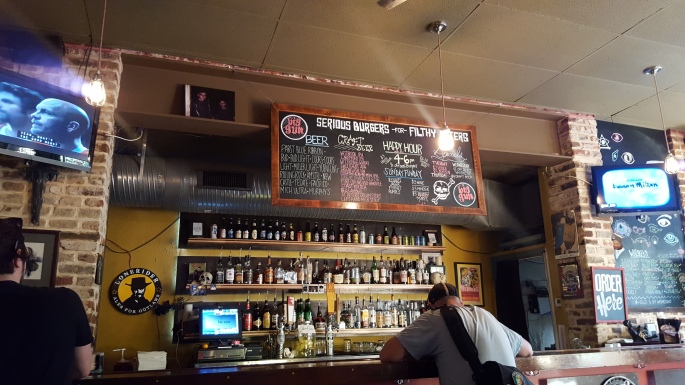
After dinner, we noticed across the street, something that looked like an artistic structure. It turned out to be a memorial for all the Holocaust survivors who ultimately ended up living in South Carolina.
Here is what google says about the monument – the monument features a concrete and bronze inscription wall, that details the history of the Holocaust and lists names of survivors living in South Carolina. The center or heart of the memorial is a four-sided iron screen measuring 25 feet wide, 60 feet long, and 17 feet high. The screen is intended to create a space that is sacred. Within the iron screen walls rests a 12 foot bronzed tallit, a Jewish prayer shawl.
I’m not sure the artist really pulled this off, when I first saw the object inside the walls, I thought someone had left an old tarp laying in the middle of the monument. Maybe it’s just my ignorance regarding the Jewish faith.
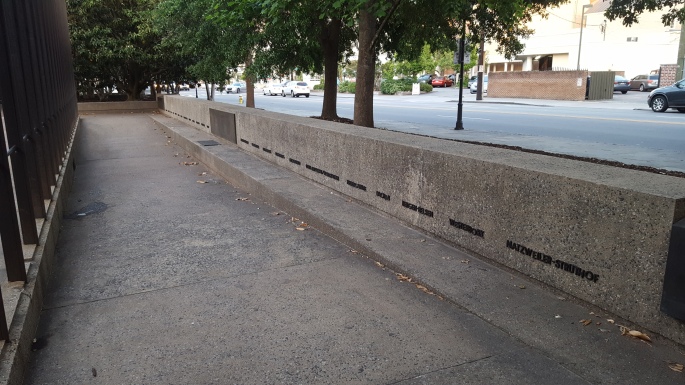

May 11 – Fri
Friday was friends & family day.
I started the day with a call to my pal from 1971, Dave Noffert.
This is the special year in which me & all my pals turn the big “60”.
March was the big “60” for Eric Deloney & Dave Vrabel.
Friday was Dave Noffert’s 60th birthday.
My time is coming in August.
Dave & Debbie Noffert will soon join us on The Loop in June.
The next call was to our Looper Pals Tyre-Less, Jim & Leslie.
They have been in Charleston for a few weeks & we had not seen them since Key West.
So we planned a dinner for Friday night.
The next phone call, was a call that I received from my pal since 1975, Dave Hinman. He is the youngster of the crowd at only 58 years old this October. Dave & Ginger will join us next week in Georgetown SC.
Then after all the phone calls, we had actual visitors.
Randy Eschels & family arrived about 11am.
Randy has been my financial advisor/planner since age 35 (1993).
I met Randy at age 35 and at the time had not been a very serious “saver/investor”.
Jonell and I had a house with a mortgage, but had savings of about only $25,000-30,000.
I had a plan & vision of where I wanted to be in 20 years, but needed some help.
Since I retired at age 57, and able to do The Loop – I believe that Randy’s influence/experience/coaching has worked out pretty darn well !
I am very grateful.
And for you young adults in your early 30’s with low bank accounts – It’s not too late , start saving & investing. Use the slow/steady approach, not the magic bullet.
Advertisement
Eschel’s Financial Group
555 S Old Woodward Ave
Birmingham, Mi, 48009
248-644-1144
Randy & family arrived about 11am.
They had spent the week up in Myrtle Beach, and wanted to stop by and say hi before they headed back home.
Randy is an avid Gettin’ Looped blog reader, and we had 2 near misses of hooking up while we were Looping and Randy was vacationing in Bay Harbor & Fort Myers Beach.
I have known Randy since 1993, but it was the first time that me & Jonell had met his wonderful family; wife Sherie, Son Garett, and Daughter Erin.


The family had come together for a week’s vacation in Myrtle Beach, with Garett coming in from Nashville, Erin coming in from Baltimore, and Randy/Sherie coming in from Michigan.
Garett works in Nashville as a financial guy, my recollection is that he is promoting insurance packages to financial planners like Randy. Garett could easily come into the Eschel’s Financial umbrella, but prefers to establish himself on his own for now.
Garett brought me a very special present, a bottle of Maker’s 46.
Maker’s 46 was the special project of the previous president , Bill Samuels, whose parents started Makers Mark. Maker’s 46 was Bill Samuel’s crowning achievement in his 46 years as president. Garett met Bill at the Kentucky Derby a few weeks ago, and was treated to a private tour of the distillery.
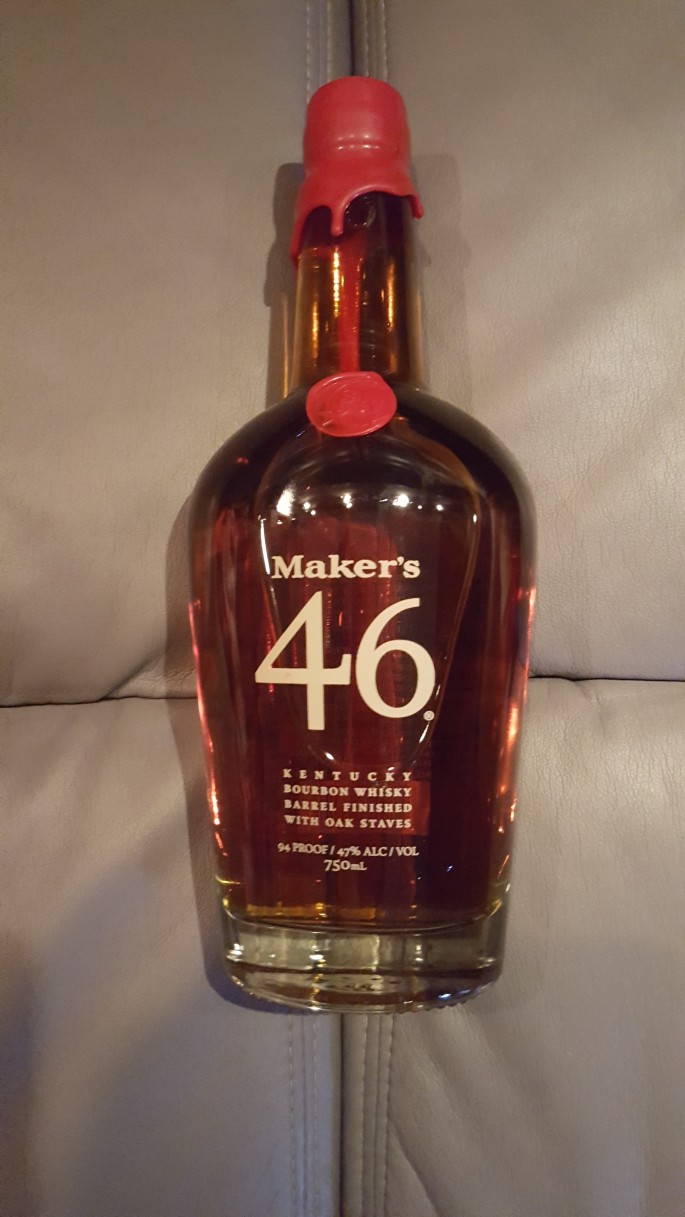
Erin lives in Baltimore, and works as a video production technician for the marketing side of the Baltimore Ravens. She interned out of Michigan State with the Tampa Bay Buccaneers, and got a full-time position with the Ravens a few years ago.
We had a wonderful discussion on the aft deck of Gettin’ Looped about; The Loop, family, work, sports, education, our children, politics, etc.
Then we went to lunch at a place across the Ashley River called California Dreaming. It was a beautiful venue on the Ashley River on a beautiful day.
And the best part – Randy Paid the bill !

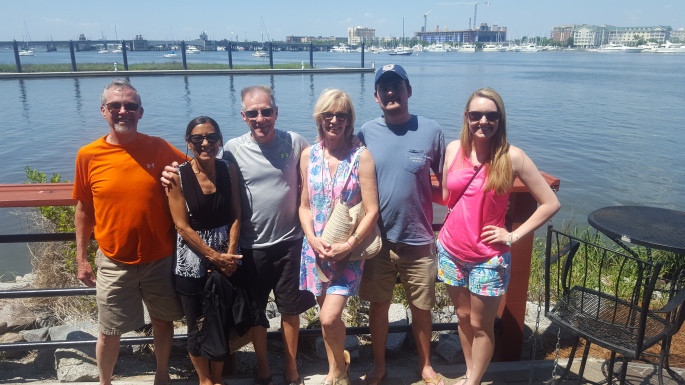
After the Eschels’ left, I took a 30 minute siesta (mid-day naps are great), Nellie read her new book, then we cleaned up for dinner with Jim & Leslie from Tyre-Less.
As I mentioned above, we had not seen Tyre-Less since Key West. We originally met them on the Ohio River, just north of Paducah Kentucky, in September of last year. It was about the same time we had met mutual friends Mother Ocean & Thistle.
Leslie & Jim had heard from 3 different sources, about a place 20 minutes away called Edmund’s Oast.
Edmund’s Oast is listed as a Brewpub/Gastropub, but as The Charleston magazine says in their review “one needn’t love beer to fall in love with Edmund’s Oast”. They called it the most important culinary establishment to open in Charleston in the last year.
They do have 48 different kinds of beer on tap, Jim & I tested 6 different offerings just between the two of us. One beer having a strong hickory smoked flavor, one had a jalapeno pepper flavor, several had chocolate flavors, and most were 6-10% alcohol.
Nellie had a light beer, Leslie drank wine & beer !

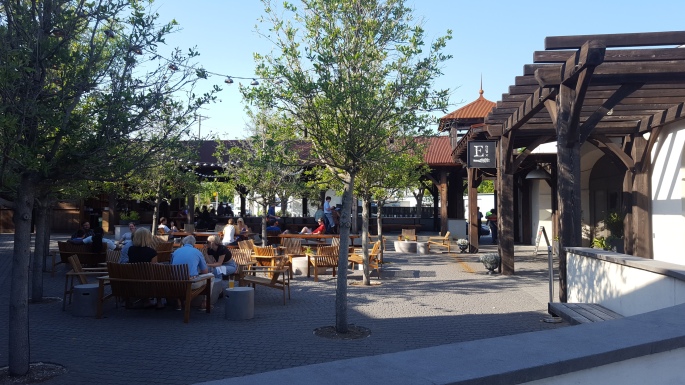
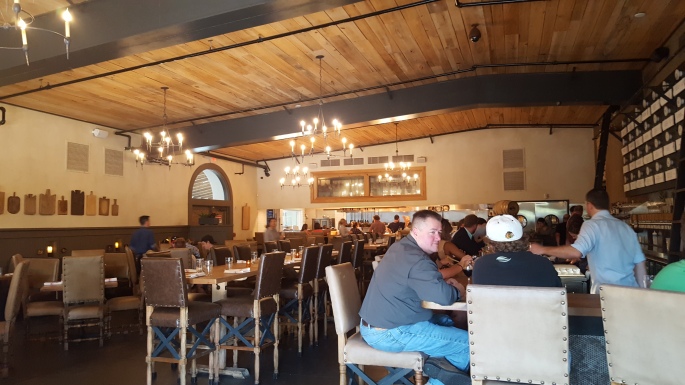
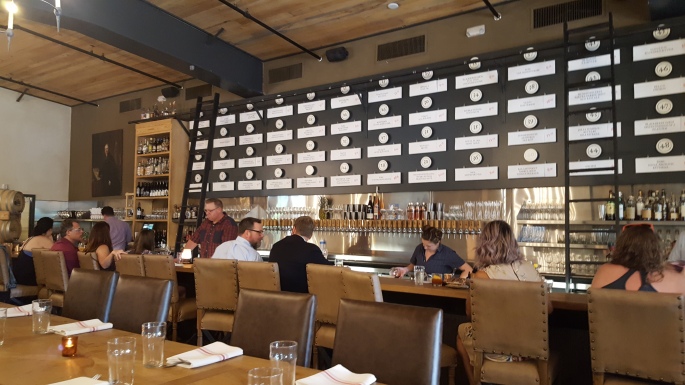
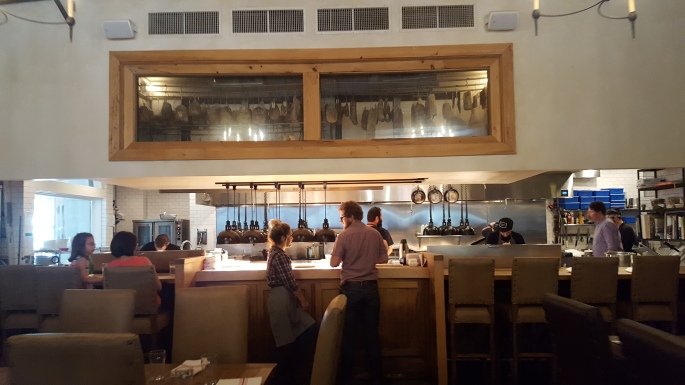

The food was excellent, with everything having a light Indian theme with curry in many of the offerings.
I had the Buttered Lamb with Carolina Gold Rice, tomato, & Fava shoots.
Nellie had the Salt Chicken with green curry, rice, lime, & schmaltz (whatever that is).
After dinner we came back & had some libations on Gettin’ Looped, then went over for a couple nite-caps on Tyre-Less, then finally called it a night.
May 12 – Sun
Sunday was prep day to travel to McKlellanville tomorrow, and Georgetown on Monday.
But prior to leaving Charleston, we wanted to squeeze in 1 more attraction, The Hunley Submarine Tour.
The Hunley Submarine Tour turned out to be one of the best attractions we have been to on The Loop.
The Hunley Facts & Timeline
> The first shots of the Civil War were fired on Fort Sumter on April 12,1861, right here in Charleston.
> 4 days after the start of the Civil War, President Lincoln imposed a blockade on all southern harbors.
> The blockades worked very well to cut off supplies to the Confederate Troops.
> The Confederate Army and General Beauregard became desperate, and by 1863 were offering $50,000 rewards for the sinking of any Union Blockade Ships.
> Confederate businessman & entrepreneur H.L. Hunley began the dream of building a submarine to bust the blockades.
> Two failed test runs of the sub occurred in 1863, killing 2 crews of 8 men each.
> Feb 17, 1864 the Hunley became the first submarine ever to record a successful battleship sinking, by sinking the Union Ship, the USS Housatonic, in Charleston Harbor.
> After completing her mission sinking the Housatonic in 1864, The Hunley mysteriously vanished and remained lost at sea for over a century.
> On May 3rd, 1995 The Hunley was found off the coast of Sullivan Island, just northeast of Charleston Harbor, by The NUMA Organization (National Underwater Marine Organization) being sponsored by NY Times award-winning author Clive Cussler.
> By August 8th, 2000, the Hunley was finally safely recovered and was delivered to the Warren Lasch Conservation Center in Charleston, a high-tech lab run by Clemson University specifically designed to conserve the vessel and unlock the mystery of her disappearance.
> Restoration of the Hunley has occurred since 1995, and is still in process.
> The docent guided tour was one of the best tours that I have ever been on.
> The Hunley is viewed by some, as the most significant artifact of The Civil War. If it would have returned safely, it may have altered the course of the Civil War.
I know the story is already long, but here is a snapshot of what is believed to have happened on the night of attack, Feb 17,1864.
> The Hunley was not a true submarine, in that it operated just below the surface of the water with about 1 foot of structure above the water.
> The Hunley was man-powered, with 8 men moving a rotating bar to propel the sub at only 5-6mph. Tides in the Charleston Harbor played a key role, because the man-power could not overcome the current rush during tidal changes.
> The sub had to open the 2 hatches to replenish air supply.
> The Confederate army had to wait weeks for the Night-Time attack, until the waves were low enough, the moon lighting was minimal, and the tide was going out.
> The Hunley did not have missiles, it had a gun powder bomb on the end of a 17ft rod attached to the front of the sub. The Hunley rammed the bomb into the side of the Housatonic, blowing a 10foot hole and sinking her in 5 minutes.
> After the successful sinking of the Housatonic, it is theorized that the sub purposely filled its ballast tanks to lay 30ft below the surface, on the bottom of Charleston Bay waiting for the tide & current to reverse back while reinforcement Union Boats circled the area. It is believed that the crew members slowly fell asleep and passed. Their remains were found in the exact positions that each man should have been at during the attack.



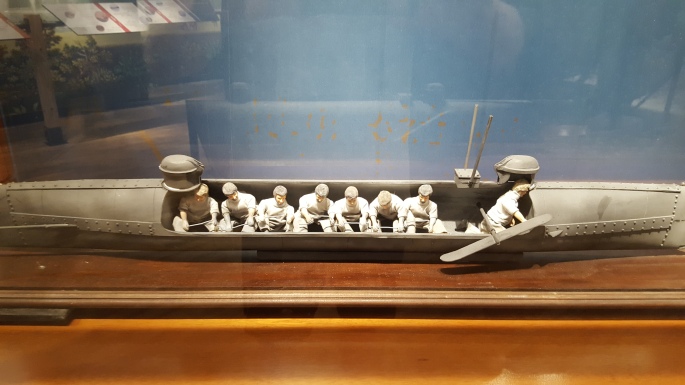

After the tour we came back to the Gettin’ Looped, wrote the blog, & prepped the ICW route for tomorrow.
Next Stops
> Sun = Leland Oil Company in McKlellanville South Carolina – 1 night
> Mon, Tue, Wed = The Harborwalk Marina in Georgetown South Carolina, where we will be joined by Dave & Ginger Hinman.

Mike, another great post from your blog. Very interesting history you are uncovering along the way. Best way to learn history is to walk it.. Second best is to be a reader of your blog. As always, wishing fair seas and good weather for trip North.
LikeLike
Thx again Brian
LikeLike
Thanks again Captain Mike for a great blog. We look forward to seeing you and first mate Jonell in September.
Wishing you safe travels as you continue your trip north.
P. S. Gonna miss the history lessons, but keep the great photos coming.
LikeLike
Thx a lot George
Knowing that I have interested readers motivates me, it is a bit time consuming
And the other goal is to turn the blog into a book when we return, there are companies that do that
C ya Geo
LikeLike
It was great seeing you and Jonell the other day. We enjoyed the tour of your boat and the time together.
Enjoy Myrtle Beach!
Ps: Thanks for the advertisement!
Randy Eschels
LikeLike
Back at ya Randy
We had a great time
You have a wonderful family
Thx for the visit, and lunch
LikeLike